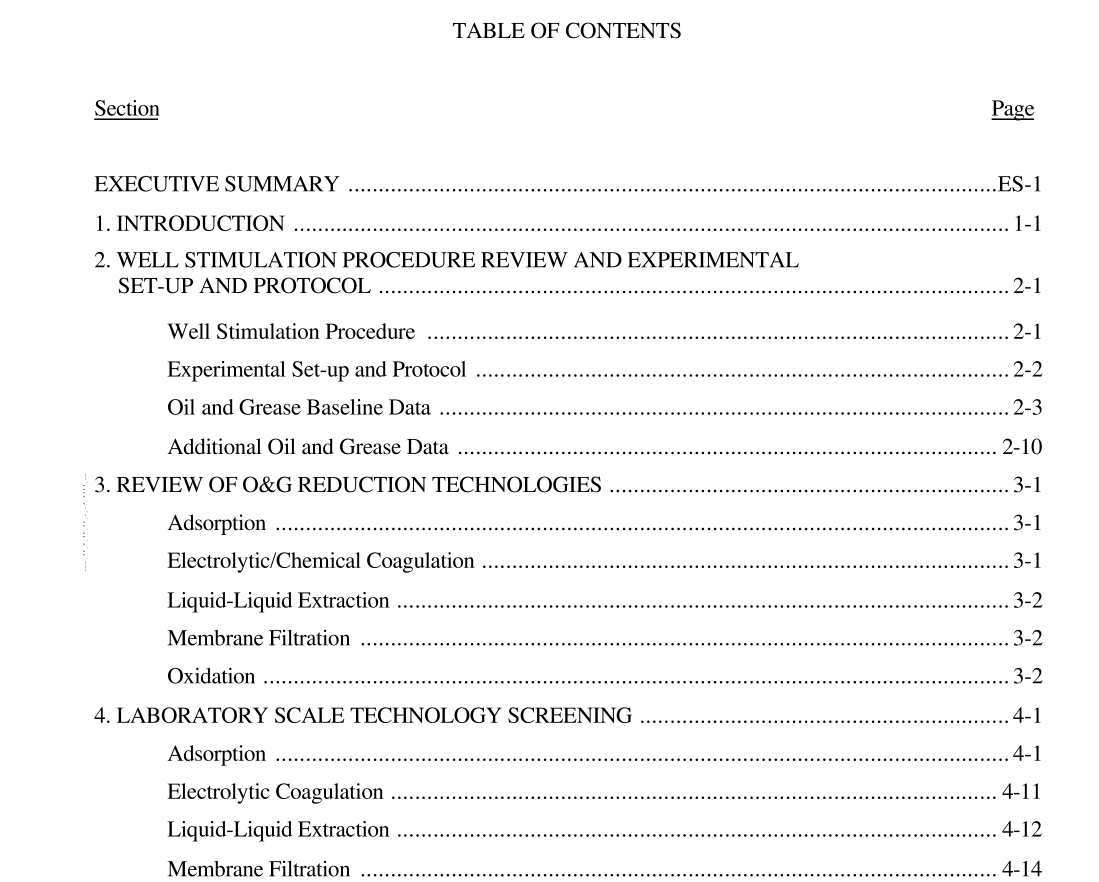API Publ 4702 pdf download

API Publ 4702 pdf download.Technologies to Reduce Oil and Grease Content of Well Treatment, Well Completion, and Workover Fluids for Overboard Disposal
The flowback of non-produced fluids (NPF) to surface de-oiling facilities on offshore platforms is a serious concern. These flowbacks create severe operational and performance problems for de-oiling water treatment processes such as gravity settling, flotation, hydrocycloning, and centrifugation. Meeting Environmental Protection Agency (EPA) oil and grease (O&G) effluent limits can be a serious challenge during flowback. The American Petroleum Institute (API) initiated an independent study to identify effective technologies for the treatment of NPF. The study was structured into three phases: initial information collection; technology review and screening at laboratory scale; and bench scale technology development of the most promising technology. To properly simulate NPF flowback, the first phase targeted the collection and review of chemical use procedures. A reduced-scale sand pack column simulated a downhole sandstone formation. Formulation and fluid preparation procedures were established for produced water, well stimulation solutions, and non-produced fluids. A nitrogen gas flotation process was used to simulate produced water de-oiling operations. Experimental protocols and O&G baseline data characterizing each fluid were rigorously established. Treatability data confirmed the impact of non-produced fluids on water treatment processes designed for O&G removal from produced water. Even at a low volumetric blending ratio of five volumes of non-produced fluids to 100 volumes of produced water, the performance of the de-oiling flotation process was reduced by as much as 70%. Next, O&G concentrations were determined for each of the four well stimulation fluids that comprise the composite non-produced fluids. O&G concentrations ranged from 1166 mg/L to 4252 mg/L. These high O&G concentrations were primarily attributed to the corrosion inhibitors, anti-sludge agents, and surfactants used.
Based on laboratory scale treatability data, two processes were initially retained: granular activated carbon (GAC) adsorption and iron-catalyzed hydrogen peroxide oxidation. Although both technologies demonstrated similar performance at laboratory scale, chemical oxidation was abandoned in favor of adsorption. This decision was based on technical and logistic scale-up considerations, safety requirements, process flexibility, process control needs, and capital costs. Bench scale technology development activities were pursued on GAC adsorption. A polymer- modified clay adsorbent (PCA) was also included in the bench scale experimental work since it has recently been introduced to offshore operations for the treatment of non-produced fluids from acidizing operations. The performance of PCA adsorption was evaluated both as an alternative to the GAC process and as a pretreatment step. Two discharge options for the treated NPF were investigated: 1) direct overboard discharge, and 2) indirect overboard discharge entailing controlled blending of treated NPF with produced water prior to final de-oiling treatment by flotation. Adsorption performance was investigated on raw NPF (R-NPF), characterized by high dissolved O&G concentrations (300 mg/L – 400 mg/L) and no free/emulsified crude oil; and on produced water–spiked NPF (PW-NPF), characterized by high dissolved and emulsified O&G concentrations (300 mg/L – 400 mg/L) and moderate concentrations of emulsified crude oil (200 mg/L).
Treatment of R-NPF and PW-NPF by GAC adsorption met the O&G discharge objective of 29 mg/L. High O&G reductions and high adsorbent capacities were measured when treating R-NPF or PW-NPF, in view of either direct or indirect discharge. This finding was expected, and correlates well with the isotherm data generated at laboratory scale. Treatment of R-NPF and PW-NPF by PCA adsorption never met the O&G discharge objective of 29 mg/L. Modest O&G reductions were measured. This finding was expected for the treatment of R-NPF, and correlates well with the isotherm data generated at laboratory scale. Treatment of PW-NPF by GAC adsorption with PCA pretreatment met the O&G discharge objective of 29 mg/L. High O&G reductions and high adsorbent capacities were measured, in view of either direct or indirect discharge. The performance of this two-stage hybrid process, however, was very similar to that provided by the single-stage GAC adsorption process. This finding was somewhat unexpected. Although laboratory and bench scale data confirmed the low adsorptive performance of PCA for O&G contaminants in R-NPF, PCA adsorption was expected to be an effective pretreatment when used in conjunction with GAC in treating PW-NPF.









